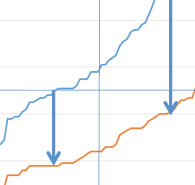CPT Data for Infra-Low Frequency Training with Cygnet
by Siegfried Othmer | June 5th, 2014by John Putman and Siegfried Othmer, PhD
 We have just reviewed all of the CPT data sets we have acquired over the last three years at the EEG Institute for which post-training data are available. The data were acquired with the QIKtest, but they were analyzed with T.O.V.A.® norms. The data cover a variety of diagnostic categories and ages. Every case represented here received infra-low frequency training with target frequency in the range of 0.1mHz to 10mHz. The results are broadly consistent with what we have observed over the years even with the higher-frequency training. Obscured in those comparisons is the fact that we are presently working successfully with a more challenged population than we did years ago.
We have just reviewed all of the CPT data sets we have acquired over the last three years at the EEG Institute for which post-training data are available. The data were acquired with the QIKtest, but they were analyzed with T.O.V.A.® norms. The data cover a variety of diagnostic categories and ages. Every case represented here received infra-low frequency training with target frequency in the range of 0.1mHz to 10mHz. The results are broadly consistent with what we have observed over the years even with the higher-frequency training. Obscured in those comparisons is the fact that we are presently working successfully with a more challenged population than we did years ago.
Shown in Figure 1 is the cumulative distribution of standard scores for the impulsivity measure, which is indexed by commission errors. The pre-training distribution was truncated at a standard score of 85, one standard deviation below the mean, which also corresponds to a percentile score of 16% (15.9%). The truncation reduced the sample to 23% of the total pool of 350. The post-training curve reflects nominally 20 sessions of training with the infra-low frequency protocols. Figure 2 shows that the median value of the distribution moves from the 2nd percentile to the 42nd. Thus we achieve substantial normalization even among those in greatest deficit. And at the top of the distribution, the 14th percentile data point moves to the 96th percentile. This means that neurofeedback is not merely normalizing performance but is in fact a means of enhancing performance. After training, 44% of the original population scores at or above the mean.
.jpg)
.jpg)
Also noteworthy is the depletion we observe within the cohort that scores most poorly. This is illustrated in Figure 3. After training, the most deficited half of the population is depleted by 86%, and only one-fourth of the population still scores less than 85. Another way to look at this is the following: If we had started with an entirely normal population, we would have expected 16% of the population to score below 85. In this case, only 25% did so after training, down from 100%. We have succeeded in nearly normalizing the entire population with respect to impulsivity. To put it another way, we moved 90% toward the goal. And it should be said that we are not finished. We have only done 20 sessions in each of these cases. Many find it beneficial to carry on to 40 sessions, and CPT scores are known to improve further. Full normalization of performance with respect to impulsivity is in prospect, albeit in this statistical sense. One can never predict the individual case.
.jpg)
.jpg)
Comparable data for the inattention measure, indexed by omission errors, are shown in Figure 4. Limiting the range to scores less than 85 yields a sample of 114, which amounts to 33% of the total test population. The median of the sample, scoring in the 1st percentile range, moves to the 28th percentile after 20 sessions of training. Some 36% score above the normative mean after the training (versus 44% in the case of impulsivity). The 60% who score in the 1st percentile range is reduced to 25% after 20 sessions, and 40% remain one standard deviation below the mean (down from 100%).
These data should be appraised with awareness that in the case of inattention there is a broad distribution of learning curves, with many taking longer to normalize function than in the case of impulsivity. The endgame is within view after 20 sessions with impulsivity, but that is not the case for inattention. Substantial further gains are in prospect with more training.






I greatly appreciate your effort to give what you have, the knowledge that transcends the gift of material returns.
A gift for the developing world where health is asset that cannot be bought if lost.
Paul Ponniah